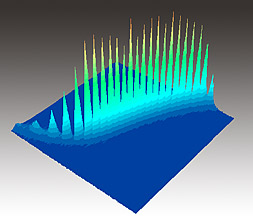|
Mainland High School
Suitable for a Disaster: ISTF 08-1835 |
||
|
Home
Introduction Contest Components One Two  Product Product
Three Fabrics History of Fabrics Smart Fabric Projects Sensors Nano Sensors Power Production Communication Cell Phones 3G Phones Data Transfer Helikites Interoperability Microwaves Relief Agencies Telecommunication Project Assessment Team |
Microwave Communication
Microwaves are one type of high frequency electromagnetic radiation that has been
used for communication purposes since the advent of wireless communication. By using
a
stream of linear radio waves in the microwave frequency, data can be transferred
wirelessly over great distances. This is the main principle behind radios and more
importantly cell phones. These waves have been traditionally generated by quartz
crystal oscillators, however, micro-oscillators may soon be a better alternative.
Crystal oscillators are created by
piezoelectric crystals vibrating to create a signal at a very precise frequency.
Microwaves are a portion of the electromagnetic spectrum ranging from 10 centimeters, 300 MHz, to 1 millimeter, 300 GHz. ISM bands, are located in a special region of the spectrum reserved for industrial, scientific, and medical applications. The name Micro-Oscillators implies really tiny microwave oscillators. More than one hundred times smaller than the current technology used in cell phone Micro-Oscillators can be used as a cheap small alternative. They work by having two small magnetic films separated by a non-magnetic strip of copper; the electrons coming into one film all have their spin oriented in the same direction. Once the second film enters, they reverse the polarity of the second film very quickly. The switching magnetic poles oscillate very fast to generate the microwave signal. NIST experiments recently confirmed predictions made by Carnegie Mellon theorists in 1966. These oscillators can have applications in wireless technologies such as internet access and cell phones. The micro-oscillator waves travel linearly to an antennae where they are received and interpreted. They could be applied to our project as the mechanism by which the suits communicate with the balloons at the mobile base. PhysLink - Cell Phone Still Too Big? Micro-Oscillators May Help http://www.physlink.com/news/012204MicroOscillator.cfm NIST Tech Beat - Cell Phone Still Too Big? Micro-Oscillators May Help http://www.nist.gov/public_affairs/techbeat/tb2004_0116.htm Terabeam - Planning a Microwave Radio Link http://www.terabeam.com/solutions/whitepapers/plan_micro_link.php Some Aspects Related to the ISM Band, especially Medical http://209.85.165.104/search? QIAJ - What's Quartz Crystal Device http://www.qiaj.jp/pages/frame20/page01-e.html Western University - Anemone Research Unit http://www.ac.wwu.edu/~gisele/curriculum.html |

